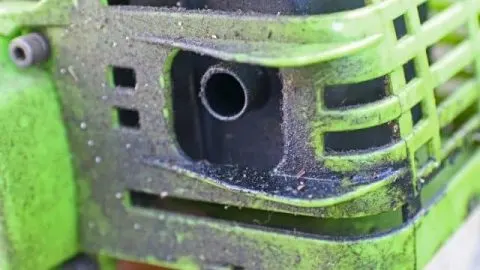Two-stroke engines have been around since 1881 but they are by no means perfect. If your two-stroke engine keeps surging, this troubleshooting guide is for you.
The most common causes of a two-stroke engine surging include lack of airflow, contaminated fuel, faulty or old spark plugs, or a maladjusted carburetor. Fixing each of these issues involves removing parts of the engine, inspecting, and possibly replacing the equipment.
To find out how to determine which of these issues is the root cause of your surging engine, read on. We will also address how to fix these issues and get to know the basics of a two-stroke engine.
The Basics of a Two-Stroke Engine
A two-stroke engine is a type of internal combustion engine. Internal combustion engines use tiny explosions to propel the engine’s inner workings and create the power to move machines.
There are two main steps or strokes in the cycle of a two-stroke engine.
Compression Stroke
In this first step, a small piece called the reed valve opens and allows a mixture of air, gas, and oil to enter the main cylinder. The piston moves upwards and puts massive pressure on this mixture in the combustion chamber. The spark plugs fire, igniting the air/gas mixture and causing a small explosion.
The explosion forces the piston downwards, which starts the next stroke in the cycle.
Power Stroke
The piston fires downwards into the chamber once more. The exhaust from the small explosion is released into the air from the exhaust port. The excess fumes and heat are expelled from the combustion chamber of the engine, almost constantly. That is why two-stroke engines can get very warm, very quickly.
Now that we know how two-stroke engines work, we can move on to determining why your engine is surging.
Lack of Airflow
One of the most important things that a two-stroke engine needs to run is a consistent airflow. The carburetor pulls air in and mixes it with a small amount of fuel, and usually oil, before delivering it into the main chamber to be compressed.
The airflow needed by the engine varies as you put different demands on the engine. Meaning, if you rev the engine or put it under a heavier load, it will need more air to stand up to the task. If there is not enough airflow or something creating an inconsistent airflow, then your engine may surge sporadically as it searches for the right amount of air around the blockage.
The Fix
To fix a lack of airflow in your engine, check all of the machine’s air filters, especially those leading into the carburetor. If these air filters get damaged or clogged, then they can quickly cause your engine to surge.
Remove the air filters and check them for clogs, rips, debris, or other damages. If the filters seem damaged at all, or even just old, replace them and try rerunning your machine.
Contaminated Fuel
One of the most common issues that two-stroke users run into without knowing it is old or contaminated fuel. If you only use your lawn care machines a few times a year, then there is a good chance that the gas in the tank has become rancid.
Any fuel that has been sitting in a machine for six months or more is no good. The fuel that has sat there for that long can get gummy and plug up the machine. This can cause a wide variety of malfunctions in your two-stroke engine, including surging.
The Fix
Check the fuel filters in your machine first to see if they are clogged. The fuel’s gumming will often catch here and stop the carburetor from providing the engine with the proper mix of air and fuel.
If the filters are clogged, remove, and replace them. You may also need to empty the gas tank of all gasoline that is inside. If the problem has been persisting for a while, then the gas tank itself may also need to be cleaned.
After you have changed the fuel filters and cleaned the gas tank, fill the tank with brand new fuel and run the machine. This will flush the new fuel into the machine and hopefully force the old fuel out.
Faulty or Old Spark Plugs
As we learned when we reviewed the basics of two-stroke engines, the spark plugs are a crucial part of the two-stroke’s functioning ability. The spark plugs need to fire reliably every cycle for the engine to work properly. A faulty spark plug may only fire once every other cycle, and in a two-stroke engine, this could easily manifest in surging.
Old spark plugs could also be the problem. As spark plugs are used, the ceramic tips of the plugs either wear down or gum up. Plugs that are either too worn or too gummed up will not work properly. They will deliver inconsistent power to the machine, and the necessary ignition of fuel may not occur.
The Fix
To fix faulty or old spark plugs, you will need to pull them out of the cylinder head and look at the prongs of the plugs. If the prongs are covered in black gunk, then they are old and need to be thrown out immediately.
If the plugs are not covered in gunk, they may still be faulty. You can test spark plugs by grounding them to something metal and trying to start your machine. If they spark consistently, then they are probably not the issue.
Maladjusted Carburetor
The carburetor is one of the most important parts of a two-stroke engine. It is also one of the most complicated parts to have to service or rebuild. Luckily, you can also adjust the carburetor, and this often fixes the problem.
Making sure the carburetor is properly adjusted is essential to the working of the machine. The carburetor makes sure that the exact right mixture of gas, air, and oil is entering the engine.
The Fix
Most two-stroke engines have two screws that allow you to adjust the carburetor. One of these screws adjusts the mixture of the gas/oil/fuel mixture, and the other screw controls the speed of the idle. To adjust the carburetor, you need to have the engine running. Slowly turn the screws to adjust the carburetor until the engine is running smoothly.
What to Do When These Options Do Not Work
If you have run through the steps above and your two-stroke engine is still surging, then it may be time to call a professional. Your problem could be something as simple as a blown gasket, or it could be as complicated as a destroyed carburetor.
It is important to only inspect what you are comfortable with when trying to fix your two-stroke engine. You could easily do more damage than good if you toy with too many things.
If you are up to the task, though, YouTuber TheRepairSpecialist has a great video on cleaning and rebuilding a carburetor:
Conclusion
If your two-stroke engine is surging, then check the four main components listed above before pulling the engine apart.
Two-stroke engines are simple, yet finicky machines. To take proper care of your two-stroke engine, it is important to make sure that you keep it well-oiled, and only use fresh fuel in the tank. If you leave your two-stroke engine sitting in storage for an extended period of time, make sure to empty the fuel tank before storing it.

